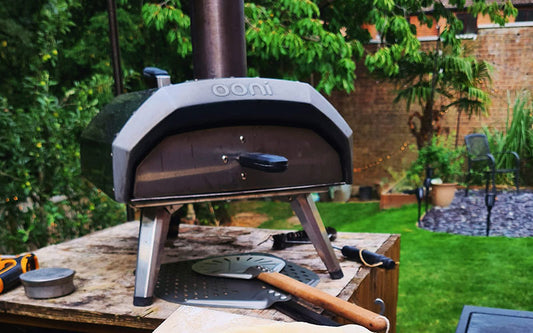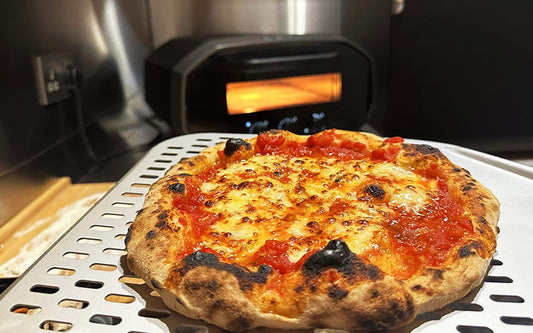Are you tired of unevenly baked pizza with a soggy center and burnt crust? It might be time to upgrade your baking game with a pizza steel. But with so many options on the market, how do you choose the right thickness?
Pizza steel thickness can range from a mere 3/16 inch (4.8mm) to a whopping 1/2 inch (12.7mm). While thinner options may be more affordable, they often lack the heat retention and durability of thicker steels.
Thicker pizza steels not only ensure a perfectly crispy crust every time, but they also last longer and can even cut down on baking time.
So which thickness is right for you? Keep reading to find out the benefits of each and make an informed decision on your next pizza steel purchase.
Does Pizza Steel Thickness Matter?
Yes, the thickness of a pizza steel can matter in terms of its performance and durability.
Thinner steels, while often more affordable, may not have the same heat retention and durability as thicker options. This can lead to an unevenly baked pizza with a soggy center and burnt crust.
Thicker pizza steels, on the contrary, have a higher heat retention capacity. It allows them to maintain a consistent temperature throughout the baking process.
Moreover, due to higher thermal mass, and thicker steels (3/8″ or above), thicker steels allow you to transfer more heat to the crust. This leads to even browning and shorter baking time.
Thicker pizza steels have several other benefits that make them a worthwhile investment for both professional chefs and serious home cooks. One of the biggest perks is their durability.
Thicker steels can withstand higher temperatures and are less prone to warping or damage over time. This makes them a more long-lasting option.
Next Read: The silicone mat: a game-changer for home pizzeria enthusiasts.
Moreover, they can potentially cut down on baking time. Because they have a higher heat retention capacity, they can maintain a consistent temperature throughout the baking process, resulting in faster baking. This can be especially useful in a busy kitchen setting where time is of the essence.
While a thinner steel may be a more budget-friendly option, it may not provide the same level of performance as its thicker counterpart. Consider your personal needs and preferences, and choose the thickness that best fits your baking goals.
Best Thickness for Pizza Steel – How Thick Should Pizza Steel Be?
So which pizza steel thickness is right for you? I’m afraid there’s no one-size-fits-all approach here.
1. NERDCHEF STEEL STONE HIGHLIGHTS
I own a 1/4″, a 3/8″, and a 1/2″ steel, and I can vouch for the fact that 1/2″ yields noticeably better results than 1/4″ steel. 3/8″ is a close second. Unless you bake frequently, a 3/8″ steel should be good enough.
Anything thinner than that can negatively affect the crust, making it too flat and dense for my taste. Granted, thicker options can be a bit pricier, but the added durability and performance may be worth the investment for heavy-duty use.
What Kind of Steel Is Used for Pizza Steel?
Pizza steels are typically made from high-carbon steel or stainless steel. High-carbon steel is a type of steel with a higher concentration of carbon compared to other steel, making it stronger and more durable. It can also withstand higher temperatures. So if you have an Ooni or a brick oven, high-carbon steel is your best bet.
On the downside, high-carbon steel can rust if not properly cared for.
The other option, stainless steel, contains at least 10.5% chromium, which makes it resistant to corrosion and staining. It is also a strong and durable option, but may not be able to withstand super high temperatures, unlike carbon steel.
Do Chefs Use Carbon Steel or Stainless Steel?
Almost every chef I have ever known personally or via the internet has a preference for carbon steel. That’s because it is easier to maintain, and it heats up faster than stainless steel. Carbon steel also has a more natural non-stick surface that makes it easier to work with.
Stainless steel is a good option if you are looking for a more durable product that won’t rust easily.
Thickness-Wise Baking Time Chart
The thickness of a pizza steel is one of the key factors that determine the baking time of a pizza. Thicker pizza steels can maintain a consistent temperature throughout the baking process. This means pies baked on thicker steel will take less time to cook compared to a pizza baked on a thinner steel.
Here is a rough estimate of the baking time for a pizza on different thicknesses of pizza steel to give you a headstart:
| Thickness (in) | Baking Time (min) |
|---|---|
| 3/16 | 6-8 |
| 1/4 | 5-7 |
| 3/8 | 4-6 |
| 1/2 | 3-5 |
Do note that these are just estimates and actual baking time may vary based on factors such as the type of oven and dough thickness. Make sure to keep a close eye on your pizza as it bakes, and use a thermometer to check for the desired internal temperature.
Thickness-Wise Preheating Time Chart
Based on my knowledge and understanding, the thickness of a pizza steel can affect the preheating time because thicker steels have a higher heat retention capacity. That means thicker steels will take longer to reach the desired cooking temperature because it has to absorb more heat.
For example, a 3/16 inch thick steel may only need 45 minutes to preheat, while a 1/2 inch thick steel may require a little shy of 90 minutes to reach the same temperature.
One preheating hack I learned while tinkering with my oven is to place a sheet of aluminum foil on top of the pizza steel while it is preheating. This can help to evenly distribute the heat and speed up the preheating process.
Next Read: Pizza Steel or Stone: The Ultimate Pizza-making Dilemma.
Just be sure to remove the foil before baking the pizza to avoid any potential issues with the crust sticking to the foil.
Below is a chart of the approximate times it takes to preheat various thicknesses of pizza steel. Again, keep in mind that these are just estimates, and how long it actually takes will depend on your oven.
| Thickness (in) | Baking Time (min) |
|---|---|
| 3/16 | 45 |
| 1/4 | 45-60 |
| 3/8 | 1 hour 10 min |
| 1/2 | 1.5 hours |
How to Choose the Best Pizza Steel Thickness Based on Your Oven Temperature
Here’s the deal. The best pizza steel thickness for your oven will depend on a variety of factors. This includes the oven temperature, the presence or absence of a broiler, and the type of pizzas you are looking to bake.
The general rule of thumb while choosing the right pizza steel thickness for your specific needs is quite straightforward:
The hotter your oven gets, the faster the top part of the crust bakes; hence, thicker steel would be ideal.
The presence or absence of a broiler should also be factored in. If your oven doesn’t have a broiler, you may be able to achieve better results using a thinner steel. It will help you cook the top and bottom of the crust at the same time.
Next Read: Upgrade your pizza-making arsenal with the best-perforated peels.
However, if your oven does have a broiler, a pizza steel with more thermal mass will ensure the top and bottom bake evenly and at the same time.
Here’s a table that outlines the ideal steel thickness for different oven temperatures (max temp with broiler):
| Oven Temperature | Recommended Pizza Steel Thickness |
| 450°F (230°C) | 3/16- 1/4 inch |
| 500°F (250°C) | 1/4-3/8 inch |
| 550°F (275°C) | 3/8-1/2 inch |
| 600°F (300°C) | 1/2 inch |
Final Word
In conclusion, choosing the right pizza steel thickness is an important consideration when it comes to baking pizzas at home. The thickness of the steel can affect how it performs in the oven, including how quickly it heats up and how evenly it cooks the pizza.
Factors such as the max temperature of your oven and broiler can also play a role in determining the best pizza steel thickness for your needs. It may take some experimentation to find the right thickness for your specific cooking style, but with a little trial and error, you can find the perfect steel to help you bake top-notch pies at home.






